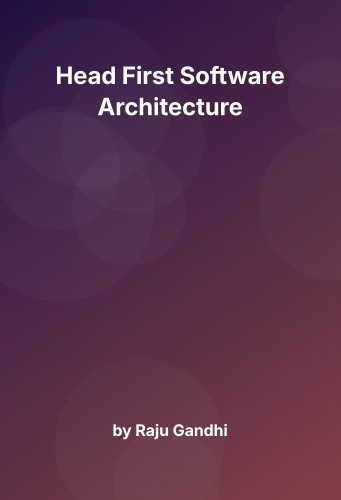Summary of “Head First Software Architecture” by Raju Gandhi
Introduction to Software Architecture
In “Head First Software Architecture,” Raju Gandhi provides a comprehensive exploration of software architecture, emphasizing practical frameworks and strategic guidance. This book is designed for professionals seeking to understand and navigate the complexities of software systems while aligning them with business goals. Gandhi begins by establishing the importance of software architecture in the digital age, highlighting its role in facilitating digital transformation and business agility.
Foundations of Software Architecture
Gandhi introduces the foundational concepts of software architecture, drawing parallels to architectural principles in construction. He emphasizes the need for a solid understanding of architectural patterns and styles, such as microservices, event-driven architectures, and serverless computing. By comparing these concepts to traditional monolithic systems, Gandhi highlights the benefits of modern architectures in terms of scalability, flexibility, and resilience. For instance, while a monolithic system might resemble a large, single building that is difficult to modify, microservices can be likened to a series of modular homes that can be individually replaced or updated, allowing for greater adaptability.
Strategic Frameworks for Architecture
The book delves into strategic frameworks guiding architectural decision-making. Gandhi presents a decision-making model that considers business objectives, technical constraints, and stakeholder needs. He integrates insights from other notable works, such as Eric Evans’ “Domain-Driven Design” and Martin Fowler’s “Patterns of Enterprise Application Architecture,” to illustrate how to align technical solutions with business domains. Gandhi’s framework is reminiscent of Christopher Alexander’s “A Pattern Language,” where architectural decisions are made through a pattern-oriented approach, ensuring that each choice aligns with the broader design objectives. This section equips professionals with the tools to make informed architectural choices that drive business success.
Navigating Complexity with Agile Practices
Gandhi explores the intersection of software architecture and agile methodologies. He argues that agile practices, such as iterative development and continuous integration, are essential for managing the complexity of modern software systems. By adopting an agile mindset, architects can ensure that their designs remain adaptable and responsive to changing business needs. Gandhi also discusses the role of DevOps in bridging the gap between development and operations, enhancing collaboration and efficiency. He compares this with the principles in “The Phoenix Project” by Gene Kim, where DevOps is portrayed as the key to unlocking organizational efficiency and adaptability.
Embracing Digital Transformation
Digital transformation is a recurring theme throughout the book. Gandhi emphasizes the need for software architects to embrace emerging technologies, such as artificial intelligence and cloud computing, to drive innovation. He discusses how these technologies can be integrated into architectural designs to create intelligent and scalable systems. By reframing traditional concepts in the context of digital transformation, Gandhi provides professionals with a roadmap for leveraging technology to achieve strategic goals. For example, he illustrates how cloud computing can be likened to renting a flexible workspace rather than owning a fixed office space, allowing companies to scale their resources according to demand.
Leadership and Communication in Architecture
Gandhi highlights the importance of leadership and communication skills for software architects. He argues that architects must be effective communicators, capable of articulating their vision to both technical and non-technical stakeholders. By fostering collaboration and building consensus, architects can ensure that their designs are aligned with organizational objectives. Gandhi provides practical advice for developing these skills, drawing on insights from leadership literature such as “Leaders Eat Last” by Simon Sinek. He underscores the importance of empathy and active listening in building a cohesive team environment.
Final Reflection: A Vision for the Future
In the concluding section, Gandhi presents a vision for the future of software architecture. He discusses the ongoing evolution of the field and the need for architects to remain adaptable and forward-thinking. By staying abreast of technological advancements and industry trends, architects can continue to drive digital transformation and deliver value to their organizations. This vision aligns with the principles in “The Lean Startup” by Eric Ries, where continuous innovation and adaptability are key to staying competitive. Gandhi’s book serves as a strategic guide for professionals seeking to navigate the challenges and opportunities of the digital age. He emphasizes a holistic approach, integrating leadership, strategic decision-making, and agile practices to ensure sustainable success across domains.
Related Resources
To complement the insights presented in the book, Gandhi includes a selection of related videos that explore relevant topics in software architecture and digital transformation. These resources provide additional perspectives and practical examples, enhancing the reader’s understanding of the concepts discussed in the book.
This summary captures the essence of “Head First Software Architecture” by Raju Gandhi, providing professionals with strategic insights and practical guidance for navigating the complexities of modern software systems. By emphasizing transformation and aligning technology with business goals, Gandhi offers a valuable resource for architects and leaders in the digital age.

